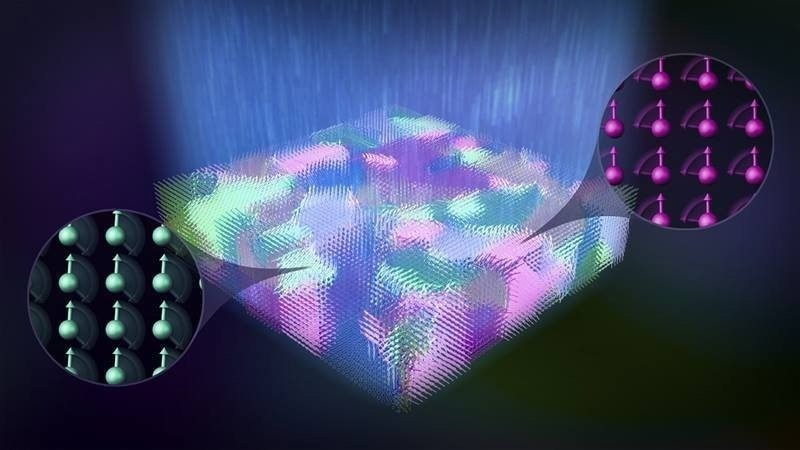Reviewed by Lexie CornerOct 28 2024
In a study published in Nano Letters, researchers demonstrated that light can change the electric polarization within the domains of a relaxor material in just trillionths of a second.
 Depiction of the dynamic atomic and nanoscale evolution of a relaxor ferroelectric following photoexcitation. Light drives ultrafast reconfigurations of the domains and rotation of the ferroelectric polarization in a few trillionths of a second. Image Credit: SLAC National Accelerator Laboratory
Depiction of the dynamic atomic and nanoscale evolution of a relaxor ferroelectric following photoexcitation. Light drives ultrafast reconfigurations of the domains and rotation of the ferroelectric polarization in a few trillionths of a second. Image Credit: SLAC National Accelerator Laboratory
Ferroelectric materials are unique because an electric field can switch their electrically positive and negative sides. Relaxor ferroelectrics, a specialized type of ferroelectric material, exhibit enhanced mechanical and electrical properties due to their unique domain structure, where polarization aligns in microscopic regions.
Understanding how quickly these properties can change is essential for leveraging these materials, yet scientists have struggled to measure their response speed. By using atomic-level ultrafast electron diffraction to capture images of the evolving domain structure, researchers were able to measure this speed. To further understand how light influences the relaxor structure, the team combined theoretical analysis with these measurements.
The Impact
Relaxors are already widely used in energy storage, sensors, transducers, and actuators, thanks to their unique characteristics derived from numerous microscopic polarization domains. A deeper understanding of these processes can drive materials science forward, and achieving rapid control over these domains could unlock even more applications.
Previous research showed that temperature or electric fields could rotate domain polarization, but the precise timing was unknown. This study reveals that rotation occurs on a picosecond timescale (a trillionth of a second). Additionally, it introduces a new method for achieving atomic- and nanoscale control of relaxor domains.
Summary
Three research teams specializing in phase-field simulation, time-resolved experiments, and material synthesis collaborated to investigate light-induced physical phenomena in relaxor ferroelectrics, focusing on PMN-0.32PT, one of the most well-known relaxors. The project utilized the Ultrafast Electron Diffraction (UED) Facility at the Linac Coherent Light Source (LCLS), a Department of Energy Office of Science user facility.
The team initiated the light-induced response using a femtosecond (one quadrillionth of a second) 266 nm laser, then used a high-energy electron beam, lasting 100 femtoseconds, to probe the diffraction pattern. By varying the delay time between the electron and laser beams, they captured femtosecond-resolution snapshots of the structure.
They observed significant changes in the intensity of specific diffraction peaks, which revealed atomic-scale movement within each unit cell. Phase-field simulations helped clarify the mechanisms by which light modulated the structure, showing that polarization could be adjusted in both magnitude and direction and that a light-induced temperature increase played a key role. This study highlights new possibilities for dynamic, reconfigurable polarization control in nanoscale relaxor ferroelectrics.
Funding
The synthesis work conducted at the University of California, Berkeley, was supported by the Army Research Office, the National Science Foundation (NSF), and the Collaborative for Hierarchical Agile and Responsive Materials. The primary funding for the study came from the Department of Energy (DOE) Office of Science, Office of Basic Energy Sciences.
Support for the theoretical work and simulations was provided by the NSF and the DOE Office of Science, Office of Basic Energy Sciences Computational Materials Sciences Program. The Linac Coherent Light Source, a DOE Office of Science user facility, also provided resources essential to the study.
Journal Reference:
Suji, P. et. al. (2024) Light-Driven Ultrafast Polarization Manipulation in a Relaxor Ferroelectric. Nano Letters. doi.org/10.1021/acs.nanolett.2c02706